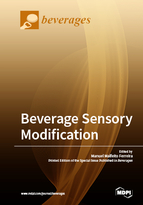Beverage Sensory Modification
A special issue of Beverages (ISSN 2306-5710).
Deadline for manuscript submissions: closed (31 December 2018) | Viewed by 59256
Special Issue Editor
Interests: food spoilage yeasts; yeast ecology; wine fermentation; wine tasting
Special Issues, Collections and Topics in MDPI journals
Special Issue Information
Dear Colleagues,
The modification of beverage sensory characteristics is a continuous goal of the food industry to meet consumer demand and increase the commercial success of new products. This pursuit gathers researchers from a wide diversity of fields, such as food chemistry, microbiology, sensory science, consumer research, and marketing. Processing technologies are also involved because novel products may require the development of new processes. Attention should also be called to sensory modifications induced by unwanted spoilage events and health issues of improved products. For this Special Issue on “Beverage Sensory Modification”, we would like to invite submissions that show what is being currently performed to improve flavor, taste and mouthfeel properties of beverages and to prevent their spoilage.
Original research and review papers are welcome under the following examples:
- Flavor, taste and mouthfeel enhancement
- Cross-modal sensory interactions
- Sensory drivers of beverage preference and liking
- The role of consumer segmentation on beverage choices
- Consumer reaction to new products (neophobia)
- Development of new tasting methodologies
- Prevention of chemical and microbiological spoilage
- Health implications of beverage formulations
- Marketing strategies of novel products
Guest Editor
Manuscript Submission Information
Manuscripts should be submitted online at www.mdpi.com by registering and logging in to this website. Once you are registered, click here to go to the submission form. Manuscripts can be submitted until the deadline. All submissions that pass pre-check are peer-reviewed. Accepted papers will be published continuously in the journal (as soon as accepted) and will be listed together on the special issue website. Research articles, review articles as well as short communications are invited. For planned papers, a title and short abstract (about 100 words) can be sent to the Editorial Office for announcement on this website.
Submitted manuscripts should not have been published previously, nor be under consideration for publication elsewhere (except conference proceedings papers). All manuscripts are thoroughly refereed through a single-blind peer-review process. A guide for authors and other relevant information for submission of manuscripts is available on the Instructions for Authors page. Beverages is an international peer-reviewed open access quarterly journal published by MDPI.
Please visit the Instructions for Authors page before submitting a manuscript. The Article Processing Charge (APC) for publication in this open access journal is 1600 CHF (Swiss Francs). Submitted papers should be well formatted and use good English. Authors may use MDPI's English editing service prior to publication or during author revisions.






